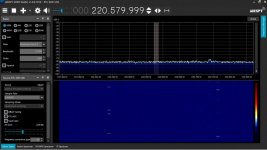I can say there definitely is a way. I’ve heard of railfans and general radio listeners decoding with SDR. However I’ve never attempted it nor really have the desire to.
You won't decode the 220 MHz PTC data. It's encrypted. What is not known yet is if the ITCM (old ATCS) protocol is encrypted or not now that most railroads are moving their ATCS data to ride along with the 220 MHz PTC signal.
You can decode the EOT, HOT and DPU signals in the 452/457.xxx range but not much data is contained in their signals. The existing ATCS data in the 900 MHz range can also be decoded but most railroads are abandoning that frequency range for ATCS and moving it onto the PTC data range in the 220 MHz band. Some railroads will keep using the new 900 MHz frequencies for ATCS data but most are moving away from the band.
The FCC is realigning the part of the 900 MHz band that railroads have been using for ATCS control and signalling for internet data which may require new radios or at the least, the reprogramming of existing radios that have the capability. Most sizable railroads are taking advantage of this and moving everything other than the 160/161.xxx MHz voice channels to the 220 MHz PTC frequencies
BNSF has always used the 160 MHz railroad band for their ARES (similar to ATCS) signal and control data channel but they are now also moving that data over to the 220 MHz PTC data channels as PTC is mandated by the AAR for most sizable railroads. This allows the railroads to only need to maintain one radio network for data and eliminate the 900.xxx radios and equipment. Of course they will still use the 160.xxx MHz railroad frequencies for voice comms which will eventually switch to NXDN digital. Some of the simple voice comms RR monitoring railfans heard in the past are now being sent over PTC which is then displayed on data terminals instead of using voice. This will reduce the amount of actual voice traffic in the 160.xxx band and make it a bit harder for railfans to monitor trains.
And who knows if the 452/457.xxx MHz EOT, HOT and DPU frequencies and equipment will stay as is but I suspect it will remain as it is today for some time.




